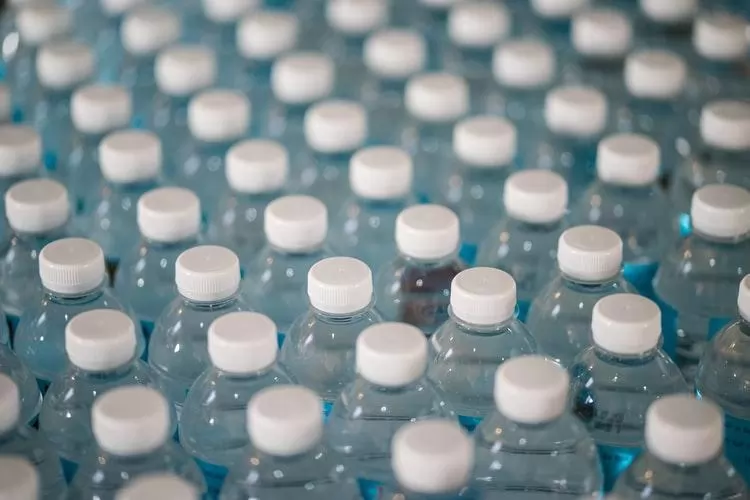Summary of our market study
In France, despite the maturity of the market, sales of bottled water grew by 3.5%, reaching 2.5 billion euros in 2023.
The global bottled water market is growing at an annual rate of 7%, and is estimated to be worth $349 billion.
French drinking habits show a strong preference for still water. The market is growing at an annual rate of around 1.5%.
A noticeable shift towards healthier choices is propelling the expansion of the flavored water segment, which is growing strongly by around 14% to 15% and is tending to replace sugary sodas.
Innovations are appearing to make bottles more environmentally friendly, such as 100% recycled PET.
France has a strong trade surplus in bottled water. The coverage rate is between 145% and 150%.
Tap water is 300 times less expensive and the leading competitor to bottled water.
The main bottled water brands on the French market
- Danone Eau: Evian, Volvic brands.
- Nestlé Waters France: Perrier and Vittel brands.
- Neptune (Groupe Alma): Cristaline brand, market leader.
- Ogeu: regional brand
- L'eau de Treignac: One of many small regional players
to understand this market
Detailed content of our market study
 Inforamtion
Inforamtion
- Number of pages : 35 pages
- Format : Digital and PDF versions
- Last update :
 Summary and extracts
Summary and extracts
1 Market overview
1.1. Market overview and definition
In France, bottled water activities include still water (spring water, mineral water and water made drinkable by treatment), sparkling water and flavored water.
The global market is enjoying sustained growth , with an estimated annual growth rate of 5.9% between 2022 and 2030. Bottled water sales are highest in China. In France, the table water market grew by 22.27% between 2015 and 2023, making it a dynamic market. What's more, France is well positioned in terms of trade, with a very large trade surplus.
The French bottled water market is concentrated around historic leaders of international stature such as Danone Eaux France, Nestlé Waters France and Neptune (a subsidiary of the Alma group), whose Cristaline brand is the market leader. Most bottled water is distributed via hypermarkets and supermarkets.
These players face two major obstacles: theecological argument and the price argument. Without recycling, bottled water has a considerable environmental footprint due to its plastic container. As a result, market players have to contend with increased competition from tap water, which is both more ecologically responsible and much more economical.
The scandal surrounding the illegal purification of bottled water is causing a stir in the market, putting the various production groups in an awkward position with consumers who may turn their backs on bottled water and opt for tap water instead.
1.2. growing global consumption
The size of the global bottled water market is estimated at $***.** billion in ****. This market is dynamic and evolving positively, and should continue to grow over the next few years, with an annual growth rate of *. *% between **** and ****.
Evolution of the size of the global bottled water market World, ****-****, in billions of dollars Source: ****
The evolution of the size of the global bottled water market between **** and **** shows a steady growth trend in sales, from $***.** billion in **** to an estimated $***.** billion in ****. This steady growth reflects sustained demand for bottled water worldwide.
Bottled water consumption, by country World, ****-****, in millions of gallons Source: ****
China leads the way with an increasing share of consumption, rising from **% in **** to **% in ****, underlining growing demand in this densely populated country. The USA also retains an important place in terms of bottled water consumption, albeit slightly less than China, with an increase from **% to **% over the period studied. India is also emerging as a major consumer country, with consumption rising sharply from *% to **% by ****, reflecting significant growth in demand in this developing country.
1.3. A growing French market
Table water industry sales trend France, ****-****, in billions of euros Source: ****
Sales growth in the table water industry in France, from **** to ****, shows a positive trend, with a **.**% increase in sales over this period.
After a slight drop in ****, sales fluctuated until ****, before declining again in ****. Sales increase again in ****, followed by a sharp rise in **** and ****, with sales reaching *.*** billion euros, marking significant growth compared to previous years.
Percentage of French people consuming bottled water France, ****-****, in % Source: ****
The trend in the percentage of French people consuming bottled water between **** and **** shows a certain stability, with relatively limited variations over the years, with the proportion of consumers fluctuating between **% and **% over this period. The rest of the population opts for tap water.
Market share of bottled water sales by value France, ****, % sales Source: ****
Market share of bottled water sales by value in France in **** shows a predominance of plain still waters, accounting for **.*% of the market, followed by plain sparkling waters at **%.
Flavored sparkling waters and flavored still waters, although less important in terms of market share, also contribute significantly, with *.*% and *.*% respectively. This breakdown highlights the diversity of consumer preferences, with strong demand for plain still waters, ...
1.4 Foreign trade in bottled water
Balance of trade for the bottled water market France, ****-****, in millions of dollars Source: ****
Over the period ****-****, the value of exports fell by *.**% from $***.* million in **** to $***.* million in **** .
Imports have also fallen slightly, from $***.* million in **** to $***.* million in ****.
Despite this decrease in trade, the coverage ratio is still well over ***, suggesting that the balance of trade in the French bottled water market is in surplus, and therefore that the value of exports exceeds the value of imports.
France's main customers France, ****, in millions of dollars Source: ****
Belgium is France's main customer in this market, with exports worth $***.* million. Germany and the United States follow close behind, with export values of $***.* million and $*** million respectively. The UK and Switzerland complete the list of major customers, although their imports of French products in this field are relatively less significant, with values of $**.* million and $**.* million respectively.
These figures underline the importance of trade partnerships between France and its European neighbors, as well as with the USA, in the bottled water sector. This breakdown of exports to different countries highlights the diversification of target markets for the French bottled water industry, contributing to its resilience and competitiveness on the international ...
2 Demand analysis
2.1. Water consumer preferences
Different types of water consumption France, ****, %, % Source : CIEAU In France in ****, the different types of water consumption reveal a marked preference for mixed water consumption, with **% of respondents declaring that they consume both tap and bottled water. The proportion of daily tap water drinkers(***). This variability in consumption preferences may be influenced by several factors, including confidence in the quality of tap water, environmental concerns linked to the use of plastic bottles, as well as individual habits and taste preferences.
Annual consumption of packaged water per capita France, ****-****, in L Source: ****
The figures show increasing per capita consumption over this period, rising from ***.* liters in **** to a peak of ***.* liters in ****, before declining slightly to ***.* liters in ****. Overall, annual per capita consumption of bottled water in France remains close to *** liters over the various years.
Market share of bottled water sales by volume France, ****, % sales Source: ****
The market share of volume sales of bottled water in France in **** highlights the predominance of still waters, representing a significant **.*% share. Plain sparkling waters follow with a market share of **. *%, while flavored sparkling waters and flavored still waters are less popular, totaling *.*% and *.*% respectively.
These data reveal a marked preference among French consumers ...
2.2 Les freins à la consommation d'eau en bouteille
La consommation d’eau en bouteille, bien que répandue en France, se heurte à plusieurs obstacles, qu’ils soient d’ordre économique, environnemental ou psychologique.
Alors que ** % des Français déclaraient avoir confiance dans l’eau du robinet en **** et ****, ce taux est tombé à ** % en **** avant de remonter légèrement à ** % en ****. Cette érosion de la confiance alimente mécaniquement le recours à l’eau en bouteille, perçue comme une alternative plus sûre, malgré un coût économique et environnemental nettement plus élevé.
Évolution de la confiance dans l'eau du robinet France, ****–****, en % Source: ****
Malgré un coût de revient près de *** fois inférieur, seuls ** % des répondants estiment que l’eau du robinet est cent fois moins chère que l’eau en bouteille. La majorité sous-évalue cet écart : ** % pensent qu’elle est dix fois moins chère, et ** % seulement deux fois moins chère. Cette perception erronée nuit à la valorisation économique de l’eau du robinet.
Perception des Français sur le prix de l'eau du robinet par rapport à l'eau en bouteille France, ****, en % Source: ****
Les Français se montrent de plus en plus sensibles aux enjeux écologiques. En ****, ** % affirmaient vouloir réduire ...
2.3 Zoom sur la consommation d'eau plate en bouteille
La consommation d’eaux plates en bouteille en France s’inscrit dans une dynamique relativement stable, soutenue par une perception positive de son rapport qualité-prix et une large diversité de profils consommateurs. D’après une enquête menée en ****, un Français sur deux juge le prix du service de l’eau du robinet plutôt bon marché. Cette perception est particulièrement forte dans les régions des Pays-de-la-Loire (***) affichent une perception plus réservée.
Répartition des dépenses en eaux plates par tranche d'âge et situation familiale France, ****, en % Source: ****
Le profil des consommateurs d’eaux plates révèle une surreprésentation des ménages seniors : les sexagénairesconcentrent à eux seuls plus de ** % des dépenses, suivis des septuagénaires et plus (***), qui ensemble représentent une part non négligeable des achats, soulignant l’importance de cette catégorie dans les dépenses du quotidien.
Répartition des dépenses d'eaux plates selon la catégorie socioprofessionnelle France, ****, % Source: ****
Sur le plan socio-économique, les classes moyennes – inférieures comme supérieures – constituent le cœur de la consommation d’eaux plates en bouteille, avec près de ** % des parts de ...
2.4 France's favourite bottled water brands
France's favorite still water brands France, March ****, in Source: ****
Cristaline emerges as the most popular brand, closely followed by Evian and Volvic. All three brands enjoy strong popularity among French consumers, with high approval ratings ranging from **.*% to **.*%.
France's favorite sparkling water brands France, March ****, in Source: ****
Perrier stands out as the most popular brand, followed by San Pellegrino and St Yorre. These three brands enjoy relatively high popularity, with approval percentages ranging from **.*% to **.*%. However, sparkling water brands are less popular than still water brands.
Comparison of the level of appreciation of X bottled water brands according to gender France, March ****, in Source: Opinionway Marque préférée des Français survey conducted in March **** - Base: representative sample of *,*** French Internet users aged ** and over Overall, women show a slightly higher level of appreciation than men for three of the four brands studied, namely Cristaline, Evian and Volvic. Men, on the other hand, show a slightly higher preference for the Perrier brand. These variations in appreciation levels between genders could be influenced by a combination of factors, such as differences in taste perception, consumption habits, individual preferences and even marketing strategies targeted specifically at each gender.
2.5 Demand boosted by repeated heatwaves
Recurrent heatwaves have an impact on the bottled water market. Heatwaves, which are becoming more frequent and intense due to climate change, have a direct effect on water consumption habits in France.
Number of heatwave days per **-year period France, ****-****, in number of days Source: ****
Analysis of the number of heatwave days per **-year period in France from **** to **** reveals an alarming trend towards more frequent and repeated heatwaves. As early as ****, an increase in the number of heatwave days was observed. However, the next two periods saw a much greater increase in the number of days, with ** heatwave days between **** and ****, and *** heatwave days between **** and ****.
Between **** and ****, the number of heatwave days per **-year period increased by ***%. This significant increase underscores clear climate change and its direct impact on the frequency of heatwaves in France.
During these hot spells, demand for bottled water rises considerably, as consumers seek to cool down and stay hydrated. The summer of ****, for example, will remain etched in the memories of bottled water distributors due to the exceptional weather conditions that encouraged record demand.
Repeated heatwaves and widespread warmth led to a marked increase in sales, propelling figures to remarkable levels. Between June ...
2.6 Vers une restriction des bouteilles plastiques de petit format ?
Au-delà de la confiance croissante accordée à l’eau du robinet, les Français se montrent de plus en plus réceptifs à des mesures visant à limiter l’impact environnemental des bouteilles en plastique. D’après un sondage OpinionWay réalisé en mai **** pour Zero Waste France et No Plastic In My Sea, ** % des Français soutiennent l’interdiction des bouteilles plastiques de petit format, dont ** % y sont tout à fait favorables.
Soutien des Français à l'interdiction des bouteilles plastiques de petit format France, mai ****, en % Source: ****
Cette adhésion à la mesure varie toutefois selon les profils. Les hommes y sont plus favorables que les femmes (***).
Écart de soutien selon les profils France, mai ****, en points de différence Source: ****
Ce soutien majoritaire à une interdiction ciblée traduit une prise de conscience environnementale croissante. Il révèle aussi que l’opinion publique semble prête à accompagner des mesures réglementaires plus strictes sur les emballages plastiques, à condition qu’elles soient perçues comme concrètes et efficaces.
3 Market structure
3.1. value chain
The bottled water value chain begins with underground water collection, or with surface water for water that has been treated. Spring and mineral waters are consumable as they are, and undergo little treatment (***). Disinfection is prohibited. Water that has been made drinkable by treatment, on the other hand, must be disinfected to be fit for consumption.
The water is then bottled and distributed either to the catering and food trades, or to hypermarkets and supermarkets (***).
3.2 Number of companies and number of employees
Growth in the number of establishments registered under activity ****A "Table water industry" France, ****-****, in number of establishments Source: ****
The evolution of the number of establishments registered under activity ****A "Table water industry" in France from **** to **** shows a general stability, with a slight variation observed over this period. The number of establishments has remained relatively constant, hovering around ** to ** establishments, with a slight increase in ****, followed by a return to the **-establishment level in **** .
This stability suggests a certain maturity in the sector, where growth is not necessarily explosive, but rather maintained at a constant level. Factors influencing this stability could include steady and consistent demand for bottled water, as well as barriers to entry into the industry with players already well established in the market.
Evolution of the number of employees registered under activity ****A "Table water industry" France, ****-****, in number of employees Source: ****
The evolution of the number of employees in this market reflects a downward trend, marked by a *% decrease in the number of employees over the years. Indeed, the total number of employees fell from **** in **** to **** in ****, with annual declines observed each year over this period.
This trend can be interpreted as the ...
3.3 A highly concentrated market
Looking at the water market, we can see that it's fairly concentrated. Three groups hold more than three-quarters of the market: Neptune and Nestlé Waters, with **.*% each, and Danone, with **.*%.
Market share of leading water brands France, ****, in Source: ****
The market is divided between Danone, Nestlé and Neptune, for both still and sparkling waters. Danone and Neptune (***) are both French groups. Nestlé is a Swiss multinational.
3.4 Distribution mainly through supermarkets
Bottled water is distributed via three main channels: supermarkets for home consumption, the catering trade for consumption in bars and restaurants, and other retail outlets (***).
Market share in value of still water distribution channels France, ****, % Source: ****
The chart above highlights the dominance of large traditional retailers such as hypermarkets and supermarkets, which hold a dominant share of bottled water distribution.
Hypermarkets lead the way with **.*%, closely followed by supermarkets with **. *%. Together, these two distribution channels account for a significant share of the still water market in France.
On the other hand, online and local distribution channels, as well as specialists, play less important roles in still water distribution, although they may offer specific market niches.
3.5 A market impacted by the vagaries of the weather
The bottled water industry in France is facing increasing challenges due to the vagaries of the climate, particularly water shortages which have intensified in recent years due to drought.
According to data collected, nearly * billion liters of mineral water are drawn from France's underground aquifers every year[***]. However, since the beginning of the year, several manufacturers have been forced to reduce their withdrawals due to the alarming drop in water levels. Well-known brands such as Wattwiller, Volvic, Vittel, Perrier and Hépar have had to adjust their production, leading to stock-outs and price increases on supermarket shelves.
In May ****, Nestlé Waters had to shut down two of its boreholes in the Vosges region of France due to unfavorable weather conditions. As a result, production of Hépar water was severely impacted, representing a significant **% drop in production capacity. These shortages have had a direct impact on consumers, who are finding it hard to find certain brands of bottled water on the market.
And yet, despite companies' efforts to reduce their environmental footprint, experts are warning that water resources could become depleted in the long term. Hydrologist Emma Haziza points out that industrial withdrawals are not sufficient to recharge the water tables, ...
4 Offer analysis
4.1. The different bottled waters available
The range of bottled waters available on the French market is fairly varied, with still waters, sparkling waters, flavored waters, etc. Still waters are the most widely sold in France (***).
The different still waters :
Types of water Characteristics Examples Mineral waters Underground in origin, they are bottled at their source. Natural mineral water is microbiologically sound and has a unique composition of mineral salts, stable over time. In fact, it's the only water with the health-promoting properties recognized by the French Academy of Medicine. Vittel and Evian are mineral waters. Spring waters Underground in origin, spring water is drinkable in its natural state and bottled at source. Unlike mineral waters, they are not required to have a stable mineral composition. Cristaline is a spring water. Water made drinkable by treatment Underground or surface water that can be treated in the same way as tap water, including disinfection. This category is not widely marketed in France The Smartwater brand marketed by Coca-Cola is a water made drinkable by treatment.
The different types of sparkling water : Types of water Characteristics Examples Natural sparkling water the gas comes from the very source of the water, linked to the earth's volcanic activity. Perrier and Quézac ...
4.2. Bottled water prices on the rise
Consumer price index for mineral and spring waters France, ****-****, index base *** in **** Source: ****
The consumer price index for mineral and spring waters in France, for the period **** to ****, shows significant fluctuations.
Initially set at *** in ****, the index showed slightly downward variations until ****. However, from **** onwards, an increase is observed, with the index exceeding *** for the first time (***) on the previous year
There may be several reasons for this recent rise in prices. Firstly, producers have passed on higher plastic prices to consumers, taking advantage of the market's oligopolistic structure to do so. In addition, in force since January *, ****,the EGalim law imposes limits on promotional advantages designed to reduce the selling price of a foodstuff to the consumer.[***] Lastly, companies in the sector faced increased challenges related to water supply, which could have been reflected in consumer prices.
Source: ****
There are significant price differences depending on the product category. For example, spring waters generally cost between ** and ** centimes per liter for a *-bottle pack, while mineral waters tend to cost between ** and ** centimes per liter.
4.3 Bottled water renews itself
More environmentally-friendly bottles
Since the ****s, plastic water bottles have been made entirely from PET (***), a fully recyclable material. Once sorted, crushed and melted to form granules, the bottles can be reused to make pens, clothing or other bottles.
However, the reality is quite different, as a large proportion of discarded bottles are still not recycled (***). In France, nearly ** million plastic bottles are thrown away every day. Less than half of these bottles are recycled, even though they could all be recycled. [***] The waste generated by the consumption of bottled water is therefore considerable.
Brands are tackling this problem by developing innovative packaging for their products. Vittel, for example, has launched its first ***% recycled PET ** cL bottle in ****. The plastic in consumed bottles comes entirely from recycling, creating a virtuous circle where waste becomes resources. Other brands are moving into this segment: this year, Nestlé Waters increased the proportion of recycled plastic in its ** cl and ** cl Vittel and Contrex bottles to **%, and to **% in its flavored varieties. [***]
The bottle solidarity cap, launched by Cristaline in ****, was another revolution in the water bottle market. This reduces pollution by preventing the cork from being misplaced in nature. The brand was awarded the ...
4.4 Offre : le scandale Nestlé Waters et ses répercussions
Tout débute en décembre ****, suite à un signalement de fraudes au sein du groupe Source: ****
À la suite de ce signalement provenant d'un salarié d'une usine du groupe Alma, la Direction générale de la concurrence, de la consommation et de la répression des fraudes (***) lance une enquête. Cette enquête révèle que l'entreprise soumet ses eaux minérales à des traitements non conformes à la réglementation : injection de sulfate de fer et de CO* industriels, microfiltration en deçà des seuils autorisés, ainsi que des mélanges d'eaux qualifiées de "minérales" ou "de source" avec de l'eau provenant du réseau, c'est-à-dire l'eau du robinet.
Pendant des années, certaines eaux ont donc été vendues comme "de source" ou "minérales naturelles" mais étaient traitées de manière non conforme, malgré les interdictions en vigueur. Une enquête menée conjointement par Le Monde et Radio France a révélé que près d'un tiers des marques françaises, dont certaines appartenant à Nestlé, ont été impliquées dans ces pratiques. Ces traitements non conformes sont principalement dus à des contaminations occasionnelles d'origine bactérienne ou chimique. Normalement, les eaux de source ...
4.5 L’eau aromatisée, une tendance prometteuse
En ****, le segment des eaux aromatisées s’impose comme l’un des moteurs de croissance du marché des BRSA, tiré par une demande croissante de boissons sans alcool, naturelles et peu sucrées. Ce segment séduit les consommateurs en quête de plaisir sain, notamment les jeunes adultes et les foyers soucieux de leur santé.
Une croissance soutenue
Le marché des eaux gazeuses aromatisées affiche une croissance dynamique de +* % en volume sur l’année ****, selon les données communiquées par Carola (***). Mais certaines marques enregistrent des performances bien supérieures : Carola, leader régional dans l’Est, a vu ses ventes d’eaux aromatisées progresser de +** % en volume sur un an.
Carola, exemple d’innovation régionale
Acteur historique de l’eau gazeuse dans l’Est de la France, Carola continue de tirer profit de sa stratégie d’innovation. En ****, la marque a lancé une nouvelle gamme de boissons prêtes à boire inspirée des mocktails, avec trois parfums : Mojito (***). Ces eaux gazeuses aromatisées sont sans sucre et élaborées à partir d’arômes naturels, avec un positionnement premium :
Format *,** L : *,** € Pack * x ** cl : *,** €
La première référence, Mojito, est également ...
5 Regulations
5.1 Current regulations
Quality criteria
Water is subject to specific regulations(***) which distinguishes, under this term, three types of water according to their origin, their stability and the treatments to which they have been subjected:
natural mineral water ; spring water ; water made potable by treatment.
Three types of bottled water:
Water made drinkable by treatment, in accordance with current regulations, may come from underground or surface resources. It must comply with the quality criteria applicable to tap water (***) and may undergo all treatments authorized for tap water, including disinfection. They are not widely marketed in France. Under current regulations, natural mineral waters and spring waters are exclusively of underground origin and must be microbiologically sound. No disinfection treatment is permitted.
However, in order to eliminate undesirable or toxic elements of natural origin (***). The exploitation and bottling of natural mineral waters and spring waters are subject to prefectoral authorization.
Spring water, water made potable by treatment and mineral water are not subject to the same quality criteria:
Spring water and water made potable by treatment must meet the same quality criteria as water delivered to the consumer's tap. They can be consumed without risk throughout a person's life. Natural mineral water must meet specific regulatory ...
5.2 Réglementation récente : augmentation du taux de TVA sur l’eau en bouteille en plastique
Dans le cadre de l’examen du Projet de Loi de Finances pour ****, un amendement déposé par la sénatrice Nadège Havet a été adopté dans la nuit du ** au ** novembre **** par le Sénat. Cet amendement prévoit une hausse du taux de TVA appliqué à l’eau en bouteille en plastique, qui passerait de *,* % à ** %.
Cette mesure repose sur un argument écologique, la sénatrice mettant en avant que l’impact carbone de l’eau en bouteille est *.*** fois supérieur à celui de l’eau du robinet, selon les données qu’elle cite. Elle estime que cette fiscalité renforcée pourrait générer *** millions d’euros de recettes supplémentaires pour l’État, tout en encourageant une consommation plus durable.
Cependant, la Maison des Eaux Minérales Naturelles, qui représente plus de ** % du chiffre d’affaires du secteur des eaux minérales (***), aurait des effets négatifs sur le pouvoir d’achat, la compétitivité des entreprises du secteur, et la chaîne de valeurdans son ensemble. Elle met aussi en garde contre un risque pour les contributions budgétaires versées par les minéraliers aux collectivités locales, dans un contexte de finances publiques ...
5.3 Vers une interdiction des bouteilles en plastique de moins de 50 cl
Le ** octobre ****, le député des Hauts-de-Seine Pierre Cazeneuve (***) a déposé une proposition de loivisant à interdire, à partir du *er janvier ****, la production, la distribution et l’utilisation des bouteilles en plastique de moins de ** centilitres. Cette mesure concerne essentiellement des contenants de ** cl et ** cl, qui représentent chaque année * millions d’unités mises sur le marché, majoritairement pour contenir de l’eau potable.
Ce projet législatif s’inscrit dans la trajectoire de sortie du plastique à usage unique d’ici ****, initiée par la loi AGEC (***). Il intervient également dans un contexte de négociations internationales sur la pollution plastique, où les petits formats sont jugés comme symboles d’« absurdité écologique », selon les termes du député.
Un débat parlementaire est prévu entre décembre **** et mars **** pour discuter de cette interdiction.
La proposition a reçu un soutien fort des associations environnementales telles que Zero Waste France, No Plastic in My Sea et Surfrider Foundation, qui demandent son inscription rapide à l’agenda législatif. Elle est aussi soutenue par Biocoop, distributeur bio pionnier, qui a cessé la vente de bouteilles plastiques dès ****, renonçant ainsi à environ ** millions d’euros de chiffre d’affaires. ...
6 Positioning the players
6. Segmentation
6.2 Oeil de l'analyste
Contexte:
Le marché français de l’eau en bouteille repose sur une structure bien établie, dominée par les eaux plates natures qui représentent ** % des ventes en valeur . Cette prédominance s'explique par une double dynamique : une consommation quotidienne ancrée dans les habitudes des Français et une croissance solide du segment (***), qui en fait aujourd’hui le principal moteur de développement du marché. En parallèle, la dimension exportatrice du secteur reste essentielle, la France enregistrant en **** un excédent commercial de plus de *** millions de dollars, porté par une forte demande à l’international. Cette orientation illustre un marché à la fois domestique et tourné vers l’étranger.
Grandes tendances:
*ᵉ tendance : Les eaux en bouteille, *ᵉ segment des boissons sans alcool en valeurAvec un chiffre d’affaires de *,** milliards d’euros en ****, les eaux en bouteille se classent derrière les soft-drinks (***), confirmant leur place centrale dans les habitudes de consommation.
*ᵉ tendance : L’Italie domine largement les importations françaises d’eau en bouteilleAvec ***,* millions de dollars, l’Italie représente à elle seule plus de ** % des importations françaises d’eau en bouteille en ****, loin devant la Belgique (***).
*ᵉ tendance : Cristaline surclasse toutes les autres marquesAvec ...
- Alma Sources (Groupe Alma - Neptune) Roxane Groupe
- Ogeu Groupe
- Nestlé Waters
- Cristaline
- Abatilles Eaux Minérales d'Arcachon
- Mont Roucous
- Hepar (Nestlé Waters)
- Fiji Water
- Evian (Danone Groupe)
- Volvic (Danone Groupe)
- Badoit (Danone)
- Perrier (Nestlé)
- Contrex (Nestlé Waters)
- Les Thermes de Vittel
- Fiée Des Lois (Intermarché Groupe)
- BE WTR
- Jolival
- Antartic
- Eau de Treignac
All our studies are available online in PDF format
Take a look at an example of our research on another market!
 Choosing this study means :
Choosing this study means :
Access to more than 35 hours of work
Our studies are the result of over 35 hours of research and analysis. Using our studies allows you to devote more time and added value to your projects.
Benefit from 6 years' experience and over 1,500 industry reports already produced
Our expertise enables us to produce comprehensive studies in all sectors, including niche and emerging markets.
Our know-how and methodology enable us to produce reports that offer unique value for money.
Access to several thousand articles and paid-for data
Businesscoot has access to all the paid economic press as well as exclusive databases to carry out its market research (over 30,000 articles and private sources).
To enhance our research, our analysts also use web indicators (semrush, trends, etc.) to identify market trends and company strategies. (Consult our paying sources)
Guaranteed support after your purchase
A team dedicated to after-sales service, to guarantee you a high level of satisfaction. +44 238 097 0676
A digital format designed for our users
Not only do you have access to a PDF, but also to a digital version designed for our customers. This version gives you access to sources, data in Excel format and graphics. The content of the study can therefore be easily retrieved and adapted for your specific needs.
 Our offers :
Our offers :
the bottled water market | France
- What are the figures on the size and growth of the market?
- What is driving the growth of the market and its evolution?
- What is the positioning of companies in the value chain?
- Data from several dozen databases
Pack 5 études (-25%) France
- 5 études au prix de 74 €HT par étude à choisir parmi nos 1200 titres sur le catalogue
- Conservez -25% sur les études supplémentaires achetées
- Choisissez le remboursement des crédits non consommés au terme des 12 mois (durée du pack)
Consultez notre catalogue d’études sectorielles


















